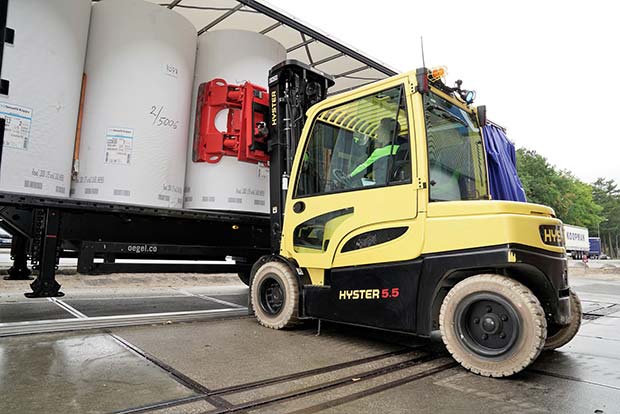Hyster Europe is helping businesses in the paper supply chain to reduce paper reel damage with a combination of damage avoidance solutions. The company also expects to improve the efficiency and productivity of drivers handling the giant paper reels and reduce the overall handling costs.

“In the paper industry damage limitation is among the most important factors when handling paper reels, whether in storage or production areas, or on the ships or quayside,” says David Reeve, Industry Manager, Counterbalance Solutions for Hyster Europe.
Reels range from 500mm to 4.6m in height, with widths usually up to 2500mm (sometimes more), and a weight between 500kg and 8 tonnes. These huge differences are due to the paper type which can be tissue, board, Kraft liner, newsprint, high quality magazine product and more.
Tissue or newsprint is relatively soft paper, prone to damage and does not require very much clamping force to lift, but equally does not tolerate excessive pressure. Magazine paper on the other hand is bigger (up to 7000kg and 4.6m high) and requires greater clamping forces, but tolerates clamping quite well.
“Different grades of paper require different clamping pressures and we work closely with expert attachment suppliers, such as Bolzoni Auramo who have a wide selection of clamps and help set the correct pressures for damage free handling” says David.
Whether a single or double tower clamp, or a rotating clamp suits the application, insufficient or excessive pressure can result in damage to the reel, which can cause problems in the printing process. This can become expensive, as the reels of paper may then need to be re-pulped.
“Hyster has introduced a gate on the hydraulic clamping function to prevent the clamping lever from activating inadvertently. The ‘Return to Set Tilt’ function also helps to ensure reels are put down flat, reducing edge damage,” David says.
“For customers in the paper industry, there is also a camera solution that enables the driver to see the bottom of the reel from inside the cab. This helps the driver place the reel down more accurately to avoid damage.”
Hyster has an increasing range of options for truck-to-truck, truck-toobject and truck-to-pedestrian detection systems. Combined with cameras, telematics and other technologies, “connected” Hyster® fleets are delivering greater productivity and visibility, helping to avoid damaging paper reels.
“Of course, in intense operating conditions reels are prone to damage due to the human factor,” says David. “Implementing the Hyster Tracker fleet management system can increase driver accountability in these operations and help to reduce stock and equipment damage. Driver training is still an essential factor, but Hyster Tracker can help to implement better driving practices and ultimately reduce impact damage and consequential downtime.”
Factors such as weight, diameter and roll width variances, paper quality, type of wrapping, storage and stowage pattern, number of rolls per cycle, and rotation for maximum efficiency still need to be considered. Hyster aims to bring fresh ideas to operations, and has introduced machines to some ports, for example, that can handle up to 8 reels at a time, significantly increasing productivity.
However, it’s not just about the clamp choice, the truck is just as important. Reliability and cost of ownership are of major importance considering the need to keep the paper moving through the supply chain at the lowest cost.
To maintain flexibility, Hyster® trucks feature quick disconnect hydraulic couplings to help to switch between clamps, forks and other attachments. Leak free O-ring fittings reduce the risk of product contamination, while multiviscosity hydraulic oil maintains lubricity longer when operating at consistently high temperatures. This protects the hydraulic system from damage caused by oil degradation.
Vented hoods minimise the vacuuming effect from under the truck and the hydraulic accumulator provides protection to the hydraulic system and truck from shock loads and prevents hydraulic slippage. This is especially important in high capacity clamping applications as it minimises paper damage from clamp arms caused by shock loads (pot holes, dock plates, etc.). It also improves operator comfort by absorbing shock loads.
Load Sensing Hydraulics help keep hydraulic pump usage to a minimum, and keep hydraulic oil cool. To increase fuel efficiency, Hyster® trucks also offer the ECOeLo mode which reduces governed engine speed and keeps truck engine coolant, transmission oil, and hydraulic oil cooler.
HYSTER




Comments are closed.